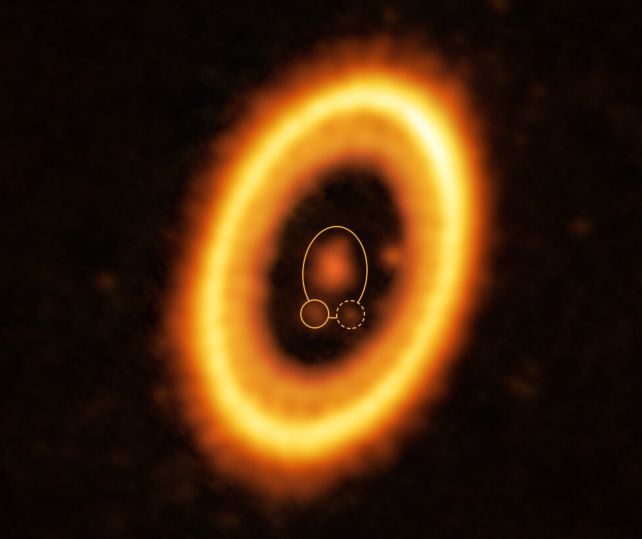First-Ever Evidence: Two Planets Found Sharing the Same Orbit
Typically, the Solar System maintains a well-organized arrangement, with each planet occupying its own distinct orbital distance from the Sun, adhering to its designated path without interference.
This semblance of order extends to many planetary systems discovered across the vast expanse of the galaxy, as they too follow a similar pattern. However, based on theoretical considerations, there exists a fascinating phenomenon where two planets might share the same orbit. For the first time, astronomers believe they have identified potential evidence of this occurrence within a fledgling planetary system situated approximately 370 light-years away from Earth.
Dubbed “Trojan planets” or “exotrojans” when referring to exoplanets, these enthralling celestial bodies draw their name from groups of asteroids that have gathered in stable gravitational points along Jupiter’s orbit, referred to as Trojan asteroids.
Astrophysicist Olga Balsalobre-Ruza, associated with the Center for Astrobiology in Spain, elaborates on the significance of this discovery, stating that two decades ago, the idea of pairs of planets with similar masses sharing an orbit around their host star—known as Trojan or co-orbital planets—was postulated in theory. Now, it seems that evidence supporting this notion has surfaced.
The exploration of this intriguing planetary arrangement adds a new layer of complexity to our understanding of celestial dynamics and holds immense promise for advancing our knowledge of planetary system formations.
Within the renowned system known as PDS-70, significant discoveries have already been made. Notably, this system provided us with the first-ever direct images of two exoplanets in the midst of their formation – these infant gas giants bear the names PDS-70b and PDS-70c. Additionally, astronomers uncovered intriguing signs of a moon-forming disk around one of these proto-exoplanets, PDS-70c.
Recent in-depth observations have led to the identification of another fascinating presence within this system – a faint blob, dimmer than the exoplanet itself, sharing the orbit of PDS-70b. While it doesn’t currently qualify as a planet, this blob has captured the attention of researchers due to its positioning. Calculations indicate that it potentially possesses a mass of up to approximately twice that of Earth’s Moon.
The significance of this discovery lies in the possibility that this enigmatic blob could be a critical stage in the planet formation process, stirring excitement among scientists eager to unlock the mysteries of planetary evolution.

Resting within what is called a Lagrange or Lagrangian point, this enigmatic blob has found its place. Each system comprising two celestial bodies possesses five of these Lagrange points: three located along the line connecting the two bodies (L1, L2, and L3), and two (L4 and L5) positioned along the orbit of the smaller body. These regions represent pockets of space where the gravitational forces between the two bodies harmoniously balance with the centripetal force necessary for a smaller body to maintain its position with them.
For instance, Jupiter’s L4 and L5 points are known as the Trojan points, home to groups of asteroids collectively referred to as Trojan asteroids. Earth, too, has its share of Trojan asteroids. These Lagrange points have proven to be advantageous locations for parking space observatories; one such example is the James Webb Space Telescope, positioned in an Earth-Sun Lagrangian.
Considering the potential for larger objects to occupy these strategically advantageous spots, it comes as no surprise that we have found this fascinating entity in the PDS-70 system, specifically residing in the L5 Lagrangian.

“Who could have envisioned the existence of two worlds sharing not only the same orbital path throughout the year but also comparable habitability conditions? Our research provides the initial evidence that such a remarkable scenario might indeed be possible,” states Balsalobre-Ruza with excitement. “While we can conceive that a planet might share its orbit with numerous asteroids, akin to Jupiter’s case, the idea of planets occupying the same orbital space is truly mind-boggling.”
Presently, it is highly probable that the celestial partner occupying this shared orbit is a dense cloud of dust, representing the fundamental building blocks of a nascent planet rather than an entire fully-formed planet. This intriguing discovery offers valuable insights not only into the likelihood of exotrojans’ formation but also the processes governing planetary system formation.
The study of PDS-70b, which bears resemblance to Jupiter, could potentially yield insights into theories concerning Jupiter’s accumulation of trojan asteroids over time and their migration from a farther point in the solar system. By examining this Jupiter-like exoplanet, we might gain a deeper understanding of these theories.
Patience will be necessary as we await answers to these captivating revelations. The research team plans to re-examine the PDS-70 system in 2026 to determine whether the enigmatic blob remains a co-orbital companion with PDS-70b in the L5 Lagrangian.
Should this prove true, it would signify a groundbreaking discovery within the realm of exoplanetary research, marking a significant milestone in our understanding of celestial dynamics and planetary formations,” Balsalobre-Ruza adds with anticipation.
Do not forget to share your opinion with us to provide you with the best posts !




0 Comments